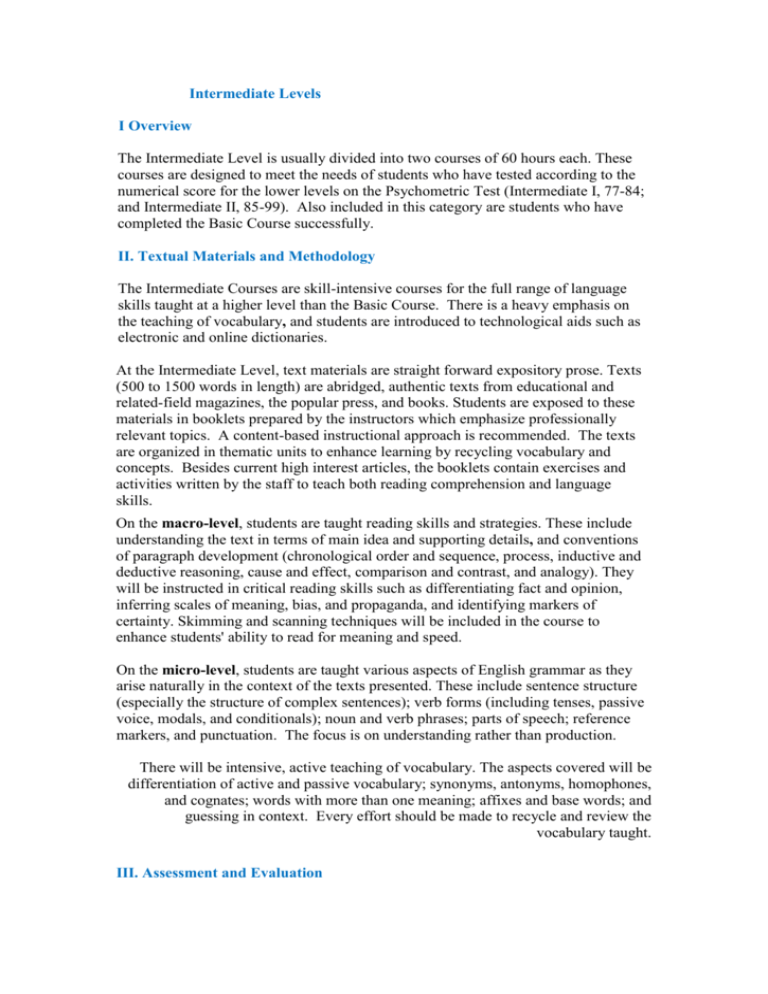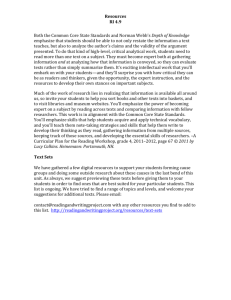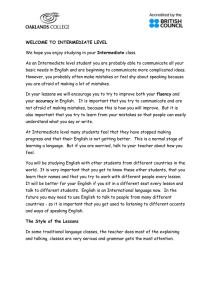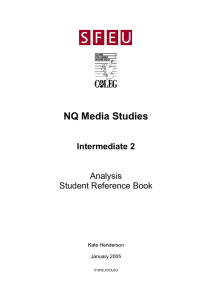Theoretical Basis for this Curriculum
advertisement

Intermediate Levels I Overview The Intermediate Level is usually divided into two courses of 60 hours each. These courses are designed to meet the needs of students who have tested according to the numerical score for the lower levels on the Psychometric Test (Intermediate I, 77-84; and Intermediate II, 85-99). Also included in this category are students who have completed the Basic Course successfully. II. Textual Materials and Methodology The Intermediate Courses are skill-intensive courses for the full range of language skills taught at a higher level than the Basic Course. There is a heavy emphasis on the teaching of vocabulary, and students are introduced to technological aids such as electronic and online dictionaries. At the Intermediate Level, text materials are straight forward expository prose. Texts (500 to 1500 words in length) are abridged, authentic texts from educational and related-field magazines, the popular press, and books. Students are exposed to these materials in booklets prepared by the instructors which emphasize professionally relevant topics. A content-based instructional approach is recommended. The texts are organized in thematic units to enhance learning by recycling vocabulary and concepts. Besides current high interest articles, the booklets contain exercises and activities written by the staff to teach both reading comprehension and language skills. On the macro-level, students are taught reading skills and strategies. These include understanding the text in terms of main idea and supporting details, and conventions of paragraph development (chronological order and sequence, process, inductive and deductive reasoning, cause and effect, comparison and contrast, and analogy). They will be instructed in critical reading skills such as differentiating fact and opinion, inferring scales of meaning, bias, and propaganda, and identifying markers of certainty. Skimming and scanning techniques will be included in the course to enhance students' ability to read for meaning and speed. On the micro-level, students are taught various aspects of English grammar as they arise naturally in the context of the texts presented. These include sentence structure (especially the structure of complex sentences); verb forms (including tenses, passive voice, modals, and conditionals); noun and verb phrases; parts of speech; reference markers, and punctuation. The focus is on understanding rather than production. There will be intensive, active teaching of vocabulary. The aspects covered will be differentiation of active and passive vocabulary; synonyms, antonyms, homophones, and cognates; words with more than one meaning; affixes and base words; and guessing in context. Every effort should be made to recycle and review the vocabulary taught. III. Assessment and Evaluation Students at intermediate levels are assessed on both the texts they have studied and on novel texts which reflect the materials they have read during the course of the semester. Tests should focus on both global understanding of the text as well as close reading. Test questions are varied and include short, open-ended questions, true and false with justifications, multiple choice type questions, translations, charts, and short paraphrasing or completions. Novel texts should be used for final examinations. IV. Integrating other skills at the Intermediate Level Students are encouraged to use their understanding of LI as an aid in comprehending L2. Wherever feasible, comparisons and contrasts between L1 and L2 are noted. Moreover, translation is used to clarify and emphasize meaning and nuances. Just as the student's experiences may be integrated into any and all cognitive experiences, the students’ language knowledge should also be acknowledged and used to the greatest advantage. In order to enhance the student's English language experience, oral proficiency is encouraged. Class activities serve to reinforce learning through group work, role play simulations, extemporaneous talks, and class discussions. These activities generally revolve around educational issues and topics students have read in the specially prepared booklets. V. Projects and Extensive Reading. Students are required to read narrative articles from the field of education as their extensive reading assignment. This aspect of the class work provides the student with an opportunity to independently apply the reading and language skills learned in class. The student is expected to prepare a short summary or graphic organizer or to answer questions pertaining to the article. Thus, a start is made in introducing the writing element into the process. Often, students are asked to discuss the article with classmates in group activities.











